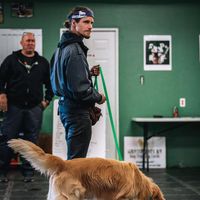Jan 20 (edited) in Blog Posts
Mastering Marker Training: Unleashing Your Dog's Emotional Communication
Today we are exploring one of the most potent tools in dog training, the Marker, often referred to as Clicker Training. Most people think of this as communication with your dog, and it is! But it can be so much more powerful than that when we peel back some layers.
What is a “Marker”:
At its face, a Marker is a signal to your dog. Most people are familiar with the term “Clicker Training”. A clicker is a Marker, but a Marker does not have to be a clicker. A Marker can be a word, a sound you make, a whistle, or anything that we can teach the dog to associate with our communication.
There are many Markers that you can take advantage of but the first and most essential is called a “Terminal Marker”. This Marker simply means they are done, they can “terminate” the command, and come get their reward. It is a release and a cue for their reward in one.
Loading the Marker: The Foundation of Success:
Loading the marker is our first step and it is relatively simple. Simply bring your dog to a distraction-free environment, click or say your Marker, and immediately give them a treat/affection/a ball or whatever you want to associate with this Marker. Now repeat, repeat, repeat. Repeat until your dog knows this like it was carved into their brain at birth. You can not possibly have this association be too strong, when you think you’re done with this exercise you’re not even halfway there. My framework when teaching a group class is I want them to do at least 20 repetitions a day for the first week.
Understanding Marker Training's True Potential:
Now, it is easy to see how this can improve communication, there is another layer I would like to emphasize. When done properly we create a conditioned response to our markers. Meaning when you are loading your marker you want to create such a strong association between the sound of your Marker and the reward being delivered that they feel like one and the same. This “conditioned response” is backed up by the theories in Classical Conditioning, you may be aware of this concept if you have heard of Pavlov’s Dogs. Explaining this process in detail will be done in a different blog post but the takeaway is that when you have a cue (click) followed by an emotion (happiness to get a treat) they start to blend together such that when the Click happens, your dog’s brain acts as if they already have the treat. We essentially can put a positive emotion on cue! Really think about how powerful that can be.
Not Just for Obedience Training:
Obviously, you can see how useful this is in obedience training. Being able to properly communicate with your dog that they have done their command and they have done it well is incredibly powerful and speeds up the process. However, this can be used to shape behaviour outside of a training session as well. Watch for good decisions throughout the day, something as simple as deciding to play with their toy instead of a shoe should be Marked for a dog who is destructive.
Perfect Timing:
Timing is everything when it comes to Marker training. One second too late or too early and you could easily create the wrong association. I have seen plenty of dogs create strange associations because of poor timing, like a dog who is convinced that they have to bark exactly two times whenever they are told Down. Poor timing also creates so much confusion for your dog, turning your communication on its head and creating frustration around training.
Marker training is a potent tool for building strong emotional bonds and shaping your dog's behavior. Beyond mere commands, it allows you to influence your dog’s feelings. A well-loaded marker, perfect timing, and thoughtful associations can transform your training sessions into a flow of communication and connection.
0
0 comments

skool.com/the-k9-classroom-4030
Providing free dog training information. Improving the lives of both owners and their dogs through education.
powered by
